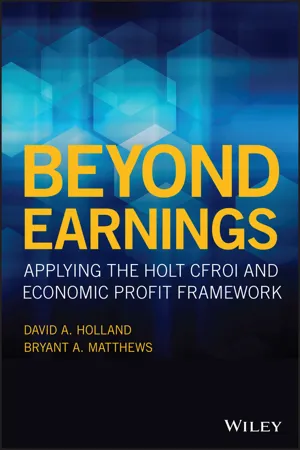
Beyond Earnings
Applying the HOLT CFROI and Economic Profit Framework
- English
- ePUB (mobile friendly)
- Available on iOS & Android
Beyond Earnings
Applying the HOLT CFROI and Economic Profit Framework
About this book
Beyond Earnings is targeted at investors, financial professionals, and students who want to improve their ability to analyze financial statements, forecast cash flows, and ultimately value a company.The authors demonstrate that reported earnings are easily gamed by accounting shenanigans and reveal how commonly used profitability measures such as return on equity can be misleading.
Because earnings and P/E ratios are too unreliable for valuation, this book takes you beyond earnings and shows you how to apply the HOLT CFROI and Economic Profit framework in a step-by-step manner.A better measure of profitability results in improved capital allocation decisions and fundamental valuations.
This ground-breaking book offers the first practical in-depth discussion of how profitability and growth fade, and shows how to put this information to work right away. The authors introduce their trailblazing Fundamental Pricing Model which includes fade as an adjustable value driver and can be used to value the impact of business model disruption.
As the authors explain, the key to superior stock picking is understanding the expectations embedded in a stock's price and having a clear view of whether the company can beat those expectations. The HOLT framework has been rigorously field tested for over 40 years by global investment professionals to help them make better stock picks and by corporate managers to understand the expectations embedded in their stock price.
Beyond Earnings is an indispensable guide for investors who want to improve their odds of outperforming the competition.
Frequently asked questions
- Essential is ideal for learners and professionals who enjoy exploring a wide range of subjects. Access the Essential Library with 800,000+ trusted titles and best-sellers across business, personal growth, and the humanities. Includes unlimited reading time and Standard Read Aloud voice.
- Complete: Perfect for advanced learners and researchers needing full, unrestricted access. Unlock 1.4M+ books across hundreds of subjects, including academic and specialized titles. The Complete Plan also includes advanced features like Premium Read Aloud and Research Assistant.
Please note we cannot support devices running on iOS 13 and Android 7 or earlier. Learn more about using the app.
Information
Section II
Discounted Cash Flow and Economic Profit Valuation
4
WHAT’S IT WORTH? VALUING THE FIRM
“The value of any stock, bond, or business today is determined by the cash inflows and outflows—discounted at an appropriate interest rate—that can be expected to occur during the remaining life of the asset.”—The Theory of Investment Value, John Burr Williams
KEY LEARNING POINTS
- We outline how to calculate and forecast free cash flow to the firm (FCFF), which is central to performing a discounted cash flow valuation.
- We show how to value the terminal period of a forecast. A fade factor can be easily incorporated, making it possible to test the sensitivity of a valuation to changes in the rate at which profitability decays.
- The calculation and utility of economic profit (EP) in assessing economic performance and valuing a firm is described. For a given forecast, discounted FCFF and EP valuations yield the same result. We value Air Liquide and demonstrate its sensitivity to profitability fade.
- We step through the calculation of FCFF in the HOLT framework, and show how it can be estimated from a CFROI and asset growth forecast.
- Different profitability and growth scenarios are valued for Amazon, indicating that it is expected to maintain high profitability and fast growth.
- Air Liquide is analyzed through the lens of the HOLT framework.
A REVIEW OF CONVENTIONAL VALUATION APPROACHES
The Entity Free Cash Flow Approach

Table of contents
- COVER
- TITLE PAGE
- TABLE OF CONTENTS
- INTRODUCTION
- Section I: Financial Performance Assessment
- Section II: Discounted Cash Flow and Economic Profit Valuation
- Section III: Value Driver Forecasting
- INDEX
- END USER LICENSE AGREEMENT